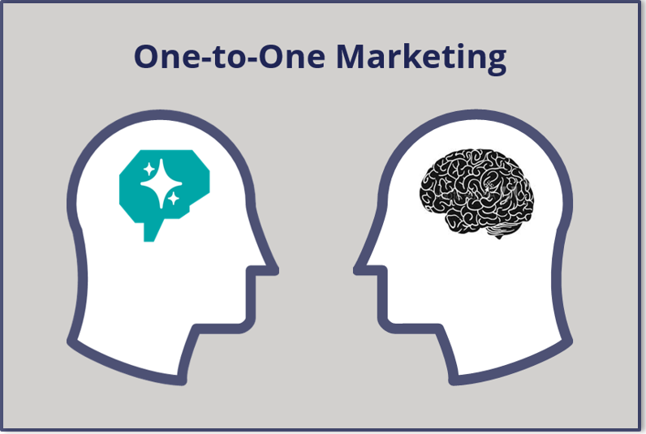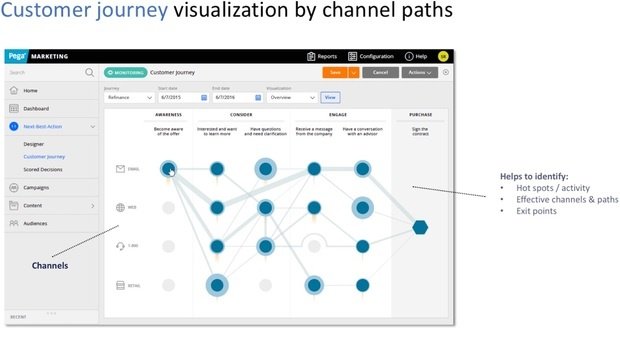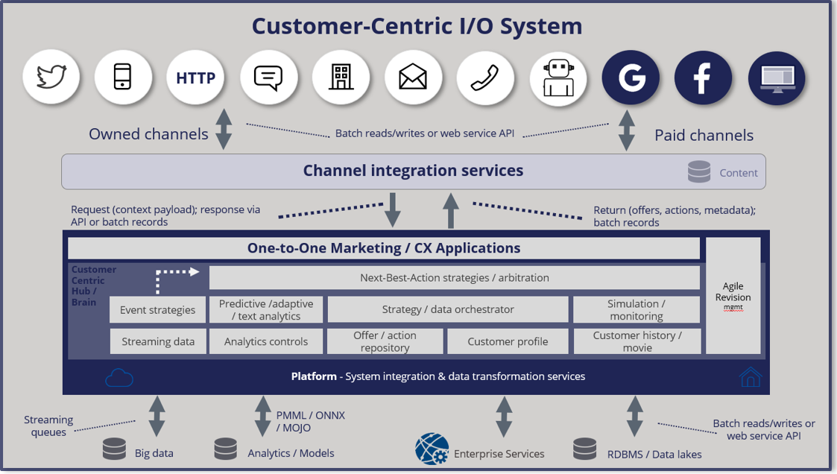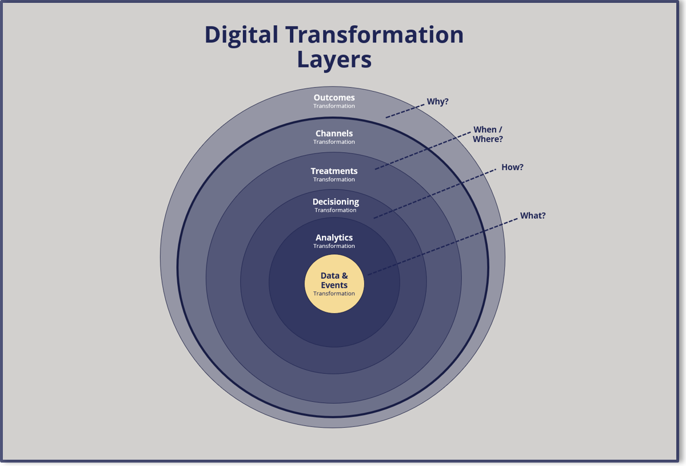
It was February 1999, and the title of the article in the Harvard Business Review was, “Is Your Company Ready for One-to-One Marketing?”[i] In it, Don Peppers, Martha Rogers, and Bob Dorf asked a series of questions about whether brands were fully prepared to do things like:
- Identify customers
- Differentiate among them
- Interact with them
- Customize and personalize the experience
Given what we experience today, these seemingly simple questions are nevertheless exceedingly relevant. Each can be asked and answered in terms of degrees of achievement and progress toward true one-to-one marketing personalization. It’s also worth noting that even now if you search Google using “one-to-one marketing” this article still ranks #4!
In the ensuing twenty years since the article surfaced, there’s evidence of reasonable progress with refined methods and tools to help. Increasingly:
- Brands effectively identify customers (as registered users, customers, visitors, prospects, partners, contacts, accounts); they also stitch together those sessions as applicable.
- There’s a whole lot less of one size for all marketing versus twenty years ago.
- Customers interact through an ever-emerging set of channels (and brands are more adept at supporting channels as they emerge).
- And (some firms) have become more customer-centric, using personalization tactics to better customize their approach to marketing.
These questions put through one lens seem to have answers that suggest one-to-one marketing was achieved years ago. After all, many would argue their company can spot customers, tell them apart, engage in conversations with them, and give some degree of personal service. Yet peer further, to levels that reveal experiential truths, and the matter won’t seem so open and shut. Ask the questions again this time slightly more poignantly:
- Are you consistently and accurately recognizing customers in every channel?
- Are you treating customers as tiers in a loyalty program or members of segments or do you treat them one at a time?
- Do you have connected conversations with them across time?
- If that conversation starts in one channel, days ago, can you pick up where it left off in an entirely different channel?
- When you interact, are you personalizing the experience; conditionally customizing and tailoring it?
- Are you constantly updating your understanding of customers, with every transaction as it happens?
- Are you doing all this in real-time?
It’s amazing how a deeper line of questioning can shed light on the reality of the situation. Although there’s an argument that progress has been made toward personalized experiences, with honest answers to the deeper questions in hand, it’s safe to say we’re not there.
So, what’s needed to progress personalization further? And as we advance it, are we forcing personalized marketing on unsuspecting consumers and ignoring that impact? Do we have a responsibility to our customers to work toward a choice and transparency model?
You can’t be sure you’re there – if you don’t know where there is
Again, on the surface, one-to-one marketing sounds simple. Just market to a person; understand their intent and needs and give them what they’re asking for – within reason (calibrated with customer value). But as we’ve seen, asking probing questions forces an inspection that goes beyond the façades and high-level concepts.
For example, asking what the “one” on the left side of one-to-one means, questions if brands have made progress methodically coordinating how customer decisions are calculated and arbitrated before delivery. If they’re better at this, then as consumers we would expect experiences to be consistent and relevant regardless of the channel, agent, time, or circumstance – a tall order that most haven’t mastered.
Another explanation of what the left-side one in one-to-one might mean is that all interactions, whether through digital or humans, feel like human to human encounters, where a meaningful relationship results and persists. If hordes of firms had mastered this, it would follow that as consumers we’d experience an efficient and empathetic touch during every interaction (regardless of whether delivered via digital or human-operated channels). Again, an admirable aspiration, though one seldom seen in practice.
Prying further, one-to-one marketing at scale suggests that an organization has perfected the ability to hyper-personalize in every interaction. For large enterprises, that means doing it during every customer interaction – millions of times a day. That kind of mass-personalization requires clean and current customer data driving conditional treatments. In turn, those conditional treatments must be custom-tailored for each customer. Yet again, as consumers, that should feel like we’re getting a perfectly fitting treatment every time.
Presently, is that how we feel about most of the marketing we encounter? Truthfully, we rarely experience flawless journeys, and so it’s premature to declare Don & Martha’s 1999 dream close to fruition.
To understand if we’re closing in on one-to-one marketing, we need an analytical measurement system. For that, we need a way of visualizing customer journeys with a scorecard that gauges progress, not in a single channel, but across all channels, journeys, and interactions. Figure 1 depicts a journey dashboard.

Figure 1: Journey Dashboard
For those that have taken steps forward, such as solid efforts to enable swift and accurate customer identification, building customer understanding with customer analytics proficiency, you’re poised to move closer. But only if your marketing platform’s foundation is sitting on bedrock and not sand, and you make other necessary organizational, functional, and process changes.
Smart transformation using a customer-centric I/O system
Much has been said and written lately about next-gen marketing automation solutions, CDPs (customer data platforms), JOE’s (journey orchestration engines), marketing clouds, and even the re-emergence of revitalized CRM systems. With each claiming to do new and exciting things like wrangling, cleansing, and distilling customer data, extracting signal from the noise, triggering actions, transforming experiences with hyper-personalization, you’d think we have all the technology necessary to make good on one-to-one marketing.
Here’s the rub. You can’t do one-to-one marketing in real-time efficiently and effectively at scale with just one of these systems. None were designed with inbound and outbound (I/O) in mind. And most were not architected using real-time transaction processing principles, but instead batch-processing and segment-oriented ideologies. That’s a sand-like foundation that sinks under the pressure when attempting to scale personalization to achieve real-time marketing.
Still, most firms have tried stitching together multiple distinct platforms – one set for outbound and another for inbound. Unknowingly, they’re compromising customer-centricity because the outbound systems they are using were built on the backs of campaign management or email service provider architectures. Those outbound systems use segment-based design principles versus mechanisms that can act on individual customers. How do I know that? I’m guilty. I helped design a number of these over the last twenty years and followed the progress of many others.
Another challenge is these outbound systems require much of the same at rest data, streaming data, rules, and analytics as the inbound system requires, so the job of trying to integrate and synchronize all that becomes an exercise in futility.
Finding one platform built on real-time transaction processing principles and capable of using a customer-centric approach for inbound and outbound (I/O) communications is rare. But you’re going to need a customer-centric I/O system if you want to get closer to true one-to-one marketing.
Figure 2 shows a proposed architecture for a one-to-one marketing system with a customer-centric I/O brain:
- Working from the bottom up, data is pumped into the brain via a variety of feeds.
- Streaming contextual data enters event strategies separating signal from noise and triggering next-best-action strategies.
- Real-time analytics predicts customer behavior, such as churn likelihood.
- Final decision arbitration ensures the right action is sent into channel services so that each customer receives in-the-moment personalized treatment. For example, a customer likely to churn because they just posted a negative review is proactively treated with a retention offer.

Figure 2: Customer-centric I/O system
The I/O engine alone, however, isn’t enough. To get to the one-to-one marketing promise land, you’ll also need an operating model that fits the new tooling. This means making functional and organizational adjustments to work effectively with the customer-centric I/O system.
Figure 3 illustrates the concentric data, analytics, content, and channel transformation necessary so that the new solution functions properly. It’s a great way to visualize each layer’s role and how a transformation of each contributes to better outcomes:
- Layer 1 – Data & Events – Transform data processing. Only batch process when warming up a brand-new system or when simulating. Otherwise, customer data processing should be transactional (as it streams), consuming, sensing, and learning from each customer data record as it occurs. Only batch and broadcast when one-size fits all makes sense, such as emergency communications.
- Layer 2 – Analytics – Renovate the analytics pipeline. This transformation demands a methodology like CRISP-DM[ii], where analytics projects start and end with business outcomes. Automate as much of the data prep, model building, and evaluation as possible. In this way, analytics becomes operationalized.
- Layer 3 – Decisioning – Install decisioning to revise corporate decision arbitration. Feeding off refined data and analytics, this layer automates and mediates the choices businesses make, resulting in improved customer experience.
- Layer 4 – Treatments – Transform how treatment variations are tested. In the new system, testing treatment versions (think content variations that include placement and timing) is continuous. Retire one-at-a-time A/B testing, because adaptive learning automatically performs multivariate tests on all the variations in play.
- Layer 5 – Channels – Alter channel selection and treatment rendering. Use revamped processes and rules that use math and science to pick the channel and timing based on predicted preference and performance.
- Layer 6 – Outcomes – Change outcome monitoring. Replace traditional reactionary monitoring with proactive sensors. When objectives show signs of falling short, adjustments are either automatically made, or the right people are proactively alerted. Reporting is consolidated to key performance metrics such as click-thru, conversion rates, and overall value added.

Figure 3: Transformation layers necessary for One-to-One Marketing
Choice plus transparency equals empathy
To deliver great experiences, a customer-centric I/O system and the environment in which it’s deployed must be both analytical and empathetic. Currently, most firms focus on analytics in pursuits of short-term profit maximization, yet few are tackling how and when mechanized systems should act empathetically to improve long-term outcomes. Are recommendation systems really producing what every individual wants and how they want it delivered, or are they simply catering to observed behaviors, reinforcing them, and serving them up in the most cost-effective way?
In 2011, Eli Pariser published his book “The Filter Bubble: What the Internet is Hiding from You.”[iii] His essential thesis is that too much pre-programmed personalization can result in a circular, self-fulfilling prophecy of behavior. If you click, tweet, post, or buy, firms assume you’re interested in that. If you don’t, you’re not.
But at times, relaxing filter rules may be a good thing. It can expose consumers to diverse ideas which have serendipitous benefits such as sparking creativity, innovation, even creating new demand. But this won’t happen if algorithmically controlled bubbles don’t include transparency, choice, and some degree of chance. Applied to one-to-one marketing, it means that we may need to:
- Ensure consumers are aware of filter bubbles. Make it easy for them to see and adjust their profile which is based on past behavior and their response to recommendations.
- Give customers the choice to receive diverse recommendations in certain circumstances, even if these suggestions don’t initially score high.
- When consumers opt-in to diverse recommendations, control placement and provide a wide mix. Let customers drive where these appear, how often, and provide them a feedback loop. The result? Customers get variety while your brand gets credit for offering choice and transparency.
To illustrate, a bank might designate an educational spot on their website. A young couple without kids may get an ad about a college savings product (which ordinarily wouldn’t rank high because they don’t have children). This could, in fact, spark family planning ideas. A retailer might surface products the customer has not previously expressed interest in, which could spur new design ideas and subsequent demand.
Conclusion
Those who envisioned one-to-one marketing foresaw a world where businesses were perfectly in tune with customers. With every need sensed, catered to, and even anticipated, consumers’ experiences were maximized and optimized. Businesses benefited because satisfied customers translated into higher lifetime value.
There’s certainly something to be said about convenience, time savings, and repeating positive experiences. Some businesses are closer to one-to-one marketing and hyper-personalization because they’ve revamped data, analytics, decision making, and treatment processes, and they’ve implemented a customer-centric I/O system; an always-on customer brain. But taken too far, and without a full understanding of evolving tastes, needs, and the value of diversity, customers are at risk of unknowingly living in a bubble – programmed by enterprises.
As consumers, we must be aware of this, and demand choice and transparency. As businesses, we should strive to deliver consumers great experiences that are both relevant in the short-run, and promote choice, individual expression, creativity, and diversity for the greater long-term good.
[i] Harvard Business Review, https://hbr.org/1999/01/is-your-company-ready-for-one-to-one-marketing, 1999
[ii] Smart Vision, https://www.sv-europe.com/crisp-dm-methodology/, 2016
[iii] Eli Pariser, The Filter Bubble: What the Internet is Hiding from You, Penguin Books, 2011



